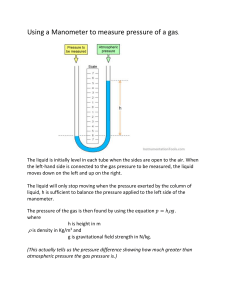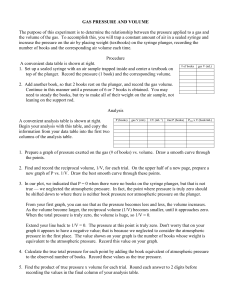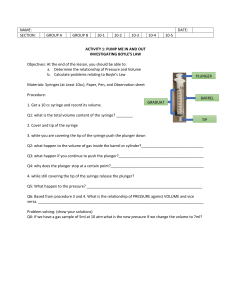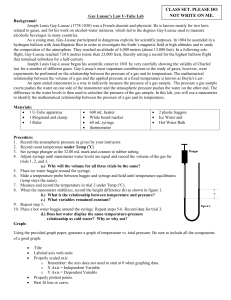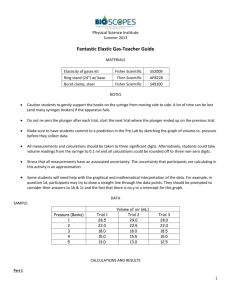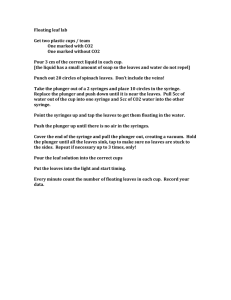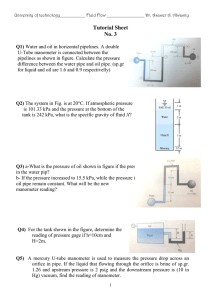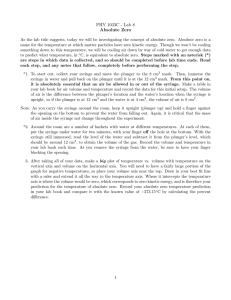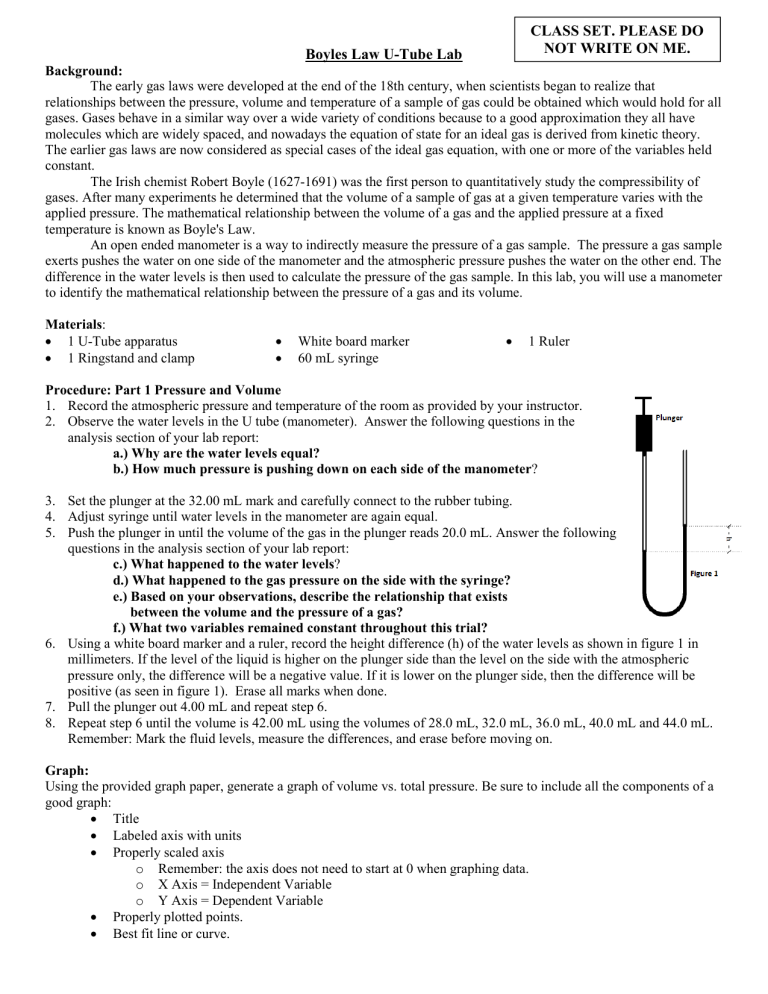
CLASS SET. PLEASE DO
NOT WRITE ON ME.
Boyles Law U-Tube Lab
Background:
The early gas laws were developed at the end of the 18th century, when scientists began to realize that relationships between the pressure, volume and temperature of a sample of gas could be obtained which would hold for all gases. Gases behave in a similar way over a wide variety of conditions because to a good approximation they all have molecules which are widely spaced, and nowadays the equation of state for an ideal gas is derived from kinetic theory.
The earlier gas laws are now considered as special cases of the ideal gas equation, with one or more of the variables held constant.
The Irish chemist Robert Boyle (1627-1691) was the first person to quantitatively study the compressibility of gases. After many experiments he determined that the volume of a sample of gas at a given temperature varies with the applied pressure. The mathematical relationship between the volume of a gas and the applied pressure at a fixed temperature is known as Boyle's Law.
An open ended manometer is a way to indirectly measure the pressure of a gas sample. The pressure a gas sample exerts pushes the water on one side of the manometer and the atmospheric pressure pushes the water on the other end. The difference in the water levels is then used to calculate the pressure of the gas sample. In this lab, you will use a manometer to identify the mathematical relationship between the pressure of a gas and its volume.
Materials :
• 1 U-Tube apparatus
• 1 Ringstand and clamp
• White board marker
• 60 mL syringe
• 1 Ruler
Procedure: Part 1 Pressure and Volume
1.
Record the atmospheric pressure and temperature of the room as provided by your instructor.
2.
Observe the water levels in the U tube (manometer). Answer the following questions in the analysis section of your lab report: a.) Why are the water levels equal?
b.) How much pressure is pushing down on each side of the manometer ?
3.
Set the plunger at the 32.00 mL mark and carefully connect to the rubber tubing.
4.
Adjust syringe until water levels in the manometer are again equal.
5.
Push the plunger in until the volume of the gas in the plunger reads 20.0 mL. Answer the following questions in the analysis section of your lab report: c.) What happened to the water levels ? d.) What happened to the gas pressure on the side with the syringe? e.) Based on your observations, describe the relationship that exists
between the volume and the pressure of a gas? f.) What two variables remained constant throughout this trial?
6.
Using a white board marker and a ruler, record the height difference (h) of the water levels as shown in figure 1 in millimeters. If the level of the liquid is higher on the plunger side than the level on the side with the atmospheric pressure only, the difference will be a negative value. If it is lower on the plunger side, then the difference will be positive (as seen in figure 1). Erase all marks when done.
7.
Pull the plunger out 4.00 mL and repeat step 6.
8.
Repeat step 6 until the volume is 42.00 mL using the volumes of 28.0 mL, 32.0 mL, 36.0 mL, 40.0 mL and 44.0 mL.
Remember: Mark the fluid levels, measure the differences, and erase before moving on.
Graph:
Using the provided graph paper, generate a graph of volume vs. total pressure. Be sure to include all the components of a good graph:
• Title
• Labeled axis with units
• Properly scaled axis o Remember: the axis does not need to start at 0 when graphing data. o X Axis = Independent Variable o Y Axis = Dependent Variable
• Properly plotted points.
• Best fit line or curve.
Name:
Boyles Law U-Tube Lab:
Purpose:
What is the relationship amongst the volume and pressure of a gas?
IV: DV:
Procedural Questions: a.) Why are the water levels equal? b.) How much pressure is pushing down on each side of the manometer? c.) What happened to the water levels? d.) What happened to the gas pressure on the side with the syringe? e.) Based on your observations, describe the relationship that exists between the volume
and the pressure of a gas? f.) What two variables remained constant throughout this trial?
Data: atmospheric pressure (mm Hg) = ____________ temperature (c) _____________
Volume (mL)
(h) (mm H
2
O)
Height difference
24.0 28.0 32.0 36.0 20.0 40.0 44.0
Calculations:
1.
Convert your Height Difference in mm H
2
O data into mm Hg for each of your volumes: 1 mm Hg = 13.6 mm H
2
O. Record your answers in the provided table, show your work under the table.
Volume (mL) 20.0 24.0 28.0 32.0 36.0 40.0 44.0
Pressure (mm Hg)
2.
Total pressure (in mm Hg) = height difference (in mm Hg) + atmospheric pressure (in mm Hg). Record your answers in the provided table, show your work under the table.
Volume (mL) 20.0 24.0 28.0 32.0 36.0 40.0 44.0
Total pressure
(mm Hg)
Graph: Volume vs. Total Pressure
Conclusion:
• Summary o What is the relationship between the volume of a gas and its pressure (direct or inverse proportionality)?
• Purpose Analysis o What is the mathematical relationship between the volume of a gas and its pressure? Give the equation. o Support your answer with data from the lab.
• Error Analysis o For this lab, we assumed that the temperature of the gas and amount of gas in the syringe remained constant. How would changing the temperature of the gas or amount of the gas in the syringe impact your results? o What steps did we take to make sure this did not happen?
• Application o Using Boyle’s Law, explain how an aerosol can works.
